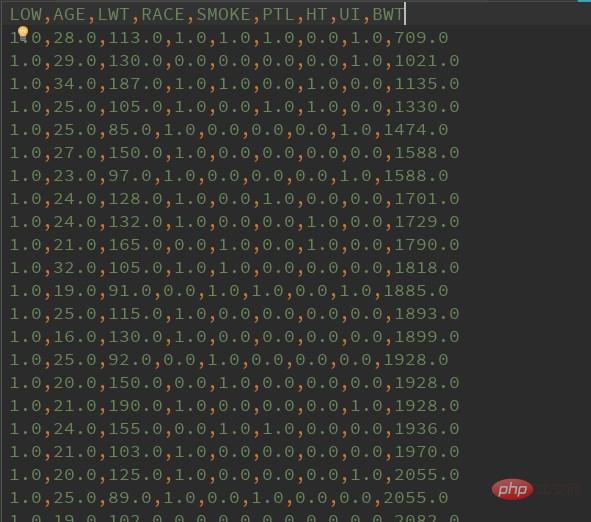How to read csv file in python

Python reads and writes csv files
Preface
Comma separated Comma-Separated Values (CSV, sometimes called character-separated values because the separator character can be other than a comma) files store tabular data (numbers and text) in plain text. Plain text means that the file is a sequence of characters and contains no data that must be interpreted like a binary number. A CSV file consists of any number of records, separated by some kind of newline character; each record consists of fields, and the separators between fields are other characters or strings, most commonly commas or tabs. Usually, all records have exactly the same field sequence.
Features
The data read out is generally character type. If it is a number, it needs to be converted manually. For numbers
Read data in row units
Columns are separated by half-width commas or tabs, usually half-width commas
Generally, there is no space at the beginning of each line , the first row is the attribute column, the data columns are separated by separators, there are no spaces, and there are no blank lines between rows.
It is very important that there are no blank lines between the lines. If there are blank lines or there are spaces at the end of the rows in the data set, an error will generally occur when reading the data, causing a [list index out of range] error. PS: I have been fooled by this error many times!
Writing and reading CSV files using python I/O
Writing csv files using Python I/O
The following is the code to download the "birthweight.dat" low birth weight dat file from the author's source, process it and save it to a csv file.
import csv
import os
import numpy as np
import random
import requests
# name of data file
# 数据集名称
birth_weight_file = 'birth_weight.csv'
# download data and create data file if file does not exist in current directory
# 如果当前文件夹下没有birth_weight.csv数据集则下载dat文件并生成csv文件
if not os.path.exists(birth_weight_file):
birthdata_url = 'https://github.com/nfmcclure/tensorflow_cookbook/raw/master/01_Introduction/07_Working_with_Data_Sources/birthweight_data/birthweight.dat'
birth_file = requests.get(birthdata_url)
birth_data = birth_file.text.split('\r\n')
# split分割函数,以一行作为分割函数,windows中换行符号为'\r\n',每一行后面都有一个'\r\n'符号。
birth_header = birth_data[0].split('\t')
# 每一列的标题,标在第一行,即是birth_data的第一个数据。并使用制表符作为划分。
birth_data = [[float(x) for x in y.split('\t') if len(x) >= 1] for y in birth_data[1:] if len(y) >= 1]
print(np.array(birth_data).shape)
# (189, 9)
# 此为list数据形式不是numpy数组不能使用np,shape函数,但是我们可以使用np.array函数将list对象转化为numpy数组后使用shape属性进行查看。
with open(birth_weight_file, "w", newline='') as f:
# with open(birth_weight_file, "w") as f:
writer = csv.writer(f)
writer.writerows([birth_header])
writer.writerows(birth_data)
f.close()
Common mistakes list index out of range
The key thing we need to talk about is with open(birth_weight_file, "w" , newline='') as f: this statement. Indicates writing a csv file. If the parameter newline='' is not added, it means using a space as a newline character. Instead, use the with open(birth_weight_file, "w") as f: statement. Blank rows will appear in the generated table.

It is not only necessary to use python I/O to read and write csv data, but also to use other methods to read and write csv data, or to download the csv data set from the Internet. Check whether there are any spaces after each line, or whether there are any extra blank lines. Avoid unnecessary errors that affect judgment during data analysis.
Use Python I/O to read csv files
When you use the python I/O method to read, you create a new List and then follow the order of rows first and columns ( Similar to a two-dimensional array in C language), store data into an empty List object. If you need to convert it into a numpy array, you can also use np.array(List name) to convert between objects.
birth_data = []
with open(birth_weight_file) as csvfile:
csv_reader = csv.reader(csvfile) # 使用csv.reader读取csvfile中的文件
birth_header = next(csv_reader) # 读取第一行每一列的标题
for row in csv_reader: # 将csv 文件中的数据保存到birth_data中
birth_data.append(row)
birth_data = [[float(x) for x in row] for row in birth_data] # 将数据从string形式转换为float形式
birth_data = np.array(birth_data) # 将list数组转化成array数组便于查看数据结构
birth_header = np.array(birth_header)
print(birth_data.shape) # 利用.shape查看结构。
print(birth_header.shape)
#
# (189, 9)
# (9,)Use Pandas to read CSV files
import pandas as pd csv_data = pd.read_csv('birth_weight.csv') # 读取训练数据 print(csv_data.shape) # (189, 9) N = 5 csv_batch_data = csv_data.tail(N) # 取后5条数据 print(csv_batch_data.shape) # (5, 9) train_batch_data = csv_batch_data[list(range(3, 6))] # 取这20条数据的3到5列值(索引从0开始) print(train_batch_data) # RACE SMOKE PTL # 184 0.0 0.0 0.0 # 185 0.0 0.0 1.0 # 186 0.0 1.0 0.0 # 187 0.0 0.0 0.0 # 188 0.0 0.0 1.0
Use Tensorflow to read CSV files
I usually do Tensorflow is used to process various types of data, so I will not explain too much about using Tensorflow to read data. I will paste a piece of code below.
'''使用Tensorflow读取csv数据'''
filename = 'birth_weight.csv'
file_queue = tf.train.string_input_producer([filename]) # 设置文件名队列,这样做能够批量读取文件夹中的文件
reader = tf.TextLineReader(skip_header_lines=1) # 使用tensorflow文本行阅读器,并且设置忽略第一行
key, value = reader.read(file_queue)
defaults = [[0.], [0.], [0.], [0.], [0.], [0.], [0.], [0.], [0.]] # 设置列属性的数据格式
LOW, AGE, LWT, RACE, SMOKE, PTL, HT, UI, BWT = tf.decode_csv(value, defaults)
# 将读取的数据编码为我们设置的默认格式
vertor_example = tf.stack([AGE, LWT, RACE, SMOKE, PTL, HT, UI]) # 读取得到的中间7列属性为训练特征
vertor_label = tf.stack([BWT]) # 读取得到的BWT值表示训练标签
# 用于给取出的数据添加上batch_size维度,以批处理的方式读出数据。可以设置批处理数据大小,是否重复读取数据,容量大小,队列末尾大小,读取线程等属性。
example_batch, label_batch = tf.train.shuffle_batch([vertor_example, vertor_label], batch_size=10, capacity=100, min_after_dequeue=10)
# 初始化Session
with tf.Session() as sess:
coord = tf.train.Coordinator() # 线程管理器
threads = tf.train.start_queue_runners(coord=coord)
print(sess.run(tf.shape(example_batch))) # [10 7]
print(sess.run(tf.shape(label_batch))) # [10 1]
print(sess.run(example_batch)[3]) # [ 19. 91. 0. 1. 1. 0. 1.]
coord.request_stop()
coord.join(threads)
'''
对于使用所有Tensorflow的I/O操作来说开启和关闭线程管理器都是必要的操作
with tf.Session() as sess:
coord = tf.train.Coordinator() # 线程管理器
threads = tf.train.start_queue_runners(coord=coord)
# Your code here~
coord.request_stop()
coord.join(threads)
'''There are other ways to read files using python. Three are introduced here and will be supplemented from time to time.
The above is the detailed content of How to read csv file in python. For more information, please follow other related articles on the PHP Chinese website!

Hot AI Tools

Undresser.AI Undress
AI-powered app for creating realistic nude photos

AI Clothes Remover
Online AI tool for removing clothes from photos.

Undress AI Tool
Undress images for free

Clothoff.io
AI clothes remover

Video Face Swap
Swap faces in any video effortlessly with our completely free AI face swap tool!

Hot Article

Hot Tools

Notepad++7.3.1
Easy-to-use and free code editor

SublimeText3 Chinese version
Chinese version, very easy to use

Zend Studio 13.0.1
Powerful PHP integrated development environment

Dreamweaver CS6
Visual web development tools

SublimeText3 Mac version
God-level code editing software (SublimeText3)

Hot Topics
 1386
1386
 52
52
 Can vs code run in Windows 8
Apr 15, 2025 pm 07:24 PM
Can vs code run in Windows 8
Apr 15, 2025 pm 07:24 PM
VS Code can run on Windows 8, but the experience may not be great. First make sure the system has been updated to the latest patch, then download the VS Code installation package that matches the system architecture and install it as prompted. After installation, be aware that some extensions may be incompatible with Windows 8 and need to look for alternative extensions or use newer Windows systems in a virtual machine. Install the necessary extensions to check whether they work properly. Although VS Code is feasible on Windows 8, it is recommended to upgrade to a newer Windows system for a better development experience and security.
 How to run programs in terminal vscode
Apr 15, 2025 pm 06:42 PM
How to run programs in terminal vscode
Apr 15, 2025 pm 06:42 PM
In VS Code, you can run the program in the terminal through the following steps: Prepare the code and open the integrated terminal to ensure that the code directory is consistent with the terminal working directory. Select the run command according to the programming language (such as Python's python your_file_name.py) to check whether it runs successfully and resolve errors. Use the debugger to improve debugging efficiency.
 Can visual studio code be used in python
Apr 15, 2025 pm 08:18 PM
Can visual studio code be used in python
Apr 15, 2025 pm 08:18 PM
VS Code can be used to write Python and provides many features that make it an ideal tool for developing Python applications. It allows users to: install Python extensions to get functions such as code completion, syntax highlighting, and debugging. Use the debugger to track code step by step, find and fix errors. Integrate Git for version control. Use code formatting tools to maintain code consistency. Use the Linting tool to spot potential problems ahead of time.
 Is the vscode extension malicious?
Apr 15, 2025 pm 07:57 PM
Is the vscode extension malicious?
Apr 15, 2025 pm 07:57 PM
VS Code extensions pose malicious risks, such as hiding malicious code, exploiting vulnerabilities, and masturbating as legitimate extensions. Methods to identify malicious extensions include: checking publishers, reading comments, checking code, and installing with caution. Security measures also include: security awareness, good habits, regular updates and antivirus software.
 Python: Automation, Scripting, and Task Management
Apr 16, 2025 am 12:14 AM
Python: Automation, Scripting, and Task Management
Apr 16, 2025 am 12:14 AM
Python excels in automation, scripting, and task management. 1) Automation: File backup is realized through standard libraries such as os and shutil. 2) Script writing: Use the psutil library to monitor system resources. 3) Task management: Use the schedule library to schedule tasks. Python's ease of use and rich library support makes it the preferred tool in these areas.
 What is vscode What is vscode for?
Apr 15, 2025 pm 06:45 PM
What is vscode What is vscode for?
Apr 15, 2025 pm 06:45 PM
VS Code is the full name Visual Studio Code, which is a free and open source cross-platform code editor and development environment developed by Microsoft. It supports a wide range of programming languages and provides syntax highlighting, code automatic completion, code snippets and smart prompts to improve development efficiency. Through a rich extension ecosystem, users can add extensions to specific needs and languages, such as debuggers, code formatting tools, and Git integrations. VS Code also includes an intuitive debugger that helps quickly find and resolve bugs in your code.
 Golang vs. Python: Concurrency and Multithreading
Apr 17, 2025 am 12:20 AM
Golang vs. Python: Concurrency and Multithreading
Apr 17, 2025 am 12:20 AM
Golang is more suitable for high concurrency tasks, while Python has more advantages in flexibility. 1.Golang efficiently handles concurrency through goroutine and channel. 2. Python relies on threading and asyncio, which is affected by GIL, but provides multiple concurrency methods. The choice should be based on specific needs.
 Can visual studio code run python
Apr 15, 2025 pm 08:00 PM
Can visual studio code run python
Apr 15, 2025 pm 08:00 PM
VS Code not only can run Python, but also provides powerful functions, including: automatically identifying Python files after installing Python extensions, providing functions such as code completion, syntax highlighting, and debugging. Relying on the installed Python environment, extensions act as bridge connection editing and Python environment. The debugging functions include setting breakpoints, step-by-step debugging, viewing variable values, and improving debugging efficiency. The integrated terminal supports running complex commands such as unit testing and package management. Supports extended configuration and enhances features such as code formatting, analysis and version control.




